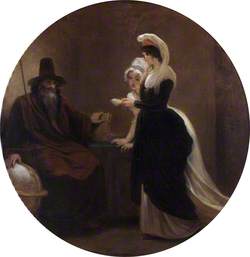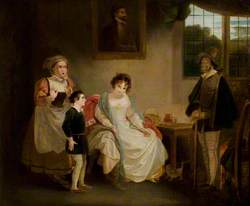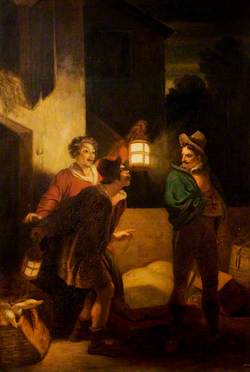How you can use this image
Notes
Add or edit a note on this artwork that only you can see. You can find notes again by going to the ‘Notes’ section of your account.
Army life in the early nineteenth century could be harsh – but the punishment for trying to escape could be harsher. Flogging, branding or even hanging, might await captured deserters, most of whom were new recruits unused to the discipline, or men about to be sent abroad without their families.
The expressions of anguish on the faces of the deserter and his family suggest that Smirke, a prominent supporter of radical politics, was aware of the hardships that encouraged desertion, and the effect on soldiers’ families. He has constructed the scene in a way that is sympathetic to the deserter. The fainting woman and the smashed crockery indicate a harmonious domestic life that has been destroyed by the violent intrusion of soldiers.
The expressions of anguish on the faces of the deserter and his family suggest that Smirke, a prominent supporter of radical politics, was aware of the hardships that encouraged desertion, and the effect on soldiers’ families. He has constructed the scene in a way that is sympathetic to the deserter. The fainting woman and the smashed crockery indicate a harmonious domestic life that has been destroyed by the violent intrusion of soldiers.
Title
The Deserter Apprehended
Date
c.1815
Medium
oil on canvas
Measurements
H 51 x W 61.2 cm
Accession number
NAM. 1964-01-4
Acquisition method
gift from Sir Alec and Lady Martin, 1964
Work type
Painting
National Army Museum
Royal Hospital Road, Chelsea, London, Greater London SW3 4HT England
This venue is open to the public. Not all artworks are on display. If you want to see a particular artwork, please contact the venue.
View venue








